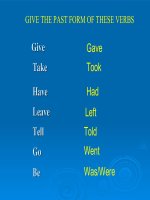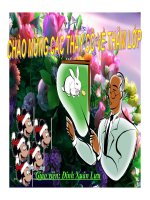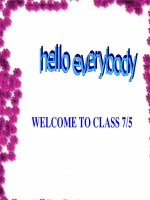- Trang chủ >>
- Mầm non - Tiểu học >>
- Lớp 5
ENGLISH 6 WEEK 22 P 64-66 UNIT 10 C1-4 UNIT 11 A1 A2
Bạn đang xem bản rút gọn của tài liệu. Xem và tải ngay bản đầy đủ của tài liệu tại đây (157.87 KB, 10 trang )
<span class='text_page_counter'>(1)</span>Date of preparing: 27/1/2021. Period:64. UNIT 10-STAYING HEALTHY LESSON 5: C1- 4 A. The aims of the lesson 1. Knowledge + The aims: By the end of the lesson , ss will be able to speak about favorite food and drink to contrast “ Would you like....?” with “ Do you like....?” * Vocab: carrots, tomatoes, lettuce, potatoes, beans, peas, cabbage onions,lemonade, iced tea, coffee, soda - like, favorite food * LF: - What's your favorite food? I like ... - Do you like carrots? Yes, I do. / No, I don't. 2. Skills : - Practice listening, speaking, reading, writing. 3. Attitude: Help ss to have good consciousness in order to Speak about favorite food and drink to contrast “ Would you like....?” with “ Do you like....?” B. Preparations 1.Teacher : posters, computer, Lesson plan, textbooks, pictures, speaker. 2. Students: Unit 10 C1-4 C. Methods: - Model-Talk-Practice, individual work, pair work - Some techniques can be used: Guessing Game, Picture drill, Word cue drill, survey D. Procedure : I.Organization: ( 1 minute) - Greeting: Good morning! - Who’s absent today? Class 6A 6B 6C. Date of teaching 2/2 ½ 3/2 Teacher ,s activities. II: warm up ( 5m). Absent Student. Students, activities ss play game.
<span class='text_page_counter'>(2)</span> Guessing Game I’d like ( a / some) ............... chicken? III: New lesson: (36’) Step 1.Presentation: 1. Pre teach vocab : - my favorite food / drink : repetition - some carrots : cà rốt - some beans : hạt đỗ - some peas : quả đỗ - iced tea : trà đá - onions : hành - lettuce (n): - lemonade (n): nước chanh 2. Picture drill: C1 P.112 Example exchange: - what are these? - They’re bananas. What are those? - They’re carrots 3.Rub out and remember dialogue: C2 Model sentences: - Do you like vegetables? Yes, I do Would you like some vegetables? No, I don’t Yes, I would / Yes, please No, I wouldn’t / No, thank you Concept checking questions: copy ( Nhấn mạnh sự khác nhau giữa “like” ( sở thích lâu dài và “would like” ( sở thích tạm thời) Step 2. Practice: Word cue drill: beans peas carrot Milk s Iced orange rice Apple tea s juice Example exchange: C - Ps S1: Do you like beans? S2: Yes, I do. S1: Would you like some beans now? S2 : No, thank / Yes, please. Step 3. Production:. S1: Would you like an orange? S2: No, I wouldn’t S3: Would you like some. ss: choral, individual copy. ss work in pairs. ss listen and answer, then. ss practice: H- H, O –Ps,.
<span class='text_page_counter'>(3)</span> * Survey : - ask ss to ask their friends and fill in the table “ Do you like chicken? “ Nam Likes ... Doesn’t e like... Nam Chicken, orange Fish .. juice Hoa Write it up: - Ask ss to write a paragraph about what their friends like or don’t like, beginning like this: Nam likes chicken and orange juice but he doesn’t like fish... ss work in groups of 5. ss work individually. IV: consolidation: V: Homework ( C1,2- workbook) Evaluation: ............................................................................................................. ................................................................................................................................ .................................................... UNIT 11 : WHAT DO YOU EAT? I/Objectives : 1. Theme: Theme 4: Nature - Food and drinks, The menu 2. Competences: - By the end of the unit, ss can buy food and drink, talk about quantities and prices, express needs and wants. 3. Skills: Speaking - Talk about wants and needs - Use appropriate language in buying food and drinks - Talk about quantities and prices Listening Listen to monologues / dialogues within 50 words for general information Reading Read dialogues and passages within 80 words for general information Writing Write sentences or a paragraph within 50 words with idea /word or picture cues 4. Grammar: - Simple present.
<span class='text_page_counter'>(4)</span> - Wh-questions: How much? How many - Yes / No questions: Can you …? - Polite requests: Would you…? / Do you like …? - Quantifiers: some, any - Partitives: a bottle of, a can of 5.Vocabulary: - Names of food `nd drinks: apple, bread, rice, meat, milk, … - Kinds of currency: VND, US$. A. Allocation Lesson 1. A1. Lesson 2 Lesson 3. A2. Lesson 4. B 1- 3. Lesson 5. B 4- 5. Practice quantifiers ( a kilo of, etc.) and containers ( a bottle of,...etc) to talk about things people buy at the stores Listen for specific information about quantities for food shopping Get “ how much” and “ how many” questions with “want” and “need” to talk about quantities for shopping Further practice in offers and requests for food and drink using “ some” “a” and “an” Talk about prices for food and drink with “ how much is it ?”. A3- 4. Date of preparing: 27/1/2021. P. 114 - 115. P . 116 P. 116 - 117 P . 119 - 120 P. 120 Period:65. UNIT 11: WHAT DO I EAT LESSON 1: A1. (P.114- 115). A. The aims of the lesson 1. Knowledge + The aims: By the end of the lesson , ss will be able to practice quantifiers ( a kilo of, etc.) and containers ( a bottle of,.etc) to talk about things people buy at the stores. *Vocabulary: a bottle of a packet of a kilo of a box of a gram of. a dozen of. a can of. a bar of. a tube of.
<span class='text_page_counter'>(5)</span> - Những từ vựng sau đây học sinh chỉ cần nhận biết: peas, soap, tooth paste, beef, cooking oil, chocolate. 2. Skills : - Practice listening, speaking, reading, writing. 3. Attitude: Help ss to have good consciousness in order to practice quantifiers ( a kilo of, etc.) and containers ( a bottle of,.etc) to talk about things people buy at the stores. B. Preparations 1.Teacher : posters, computer, Lesson plan, textbooks, pictures, speaker. 2. Students: Unit 11 A1 C. Methods: - Model-Talk-Practice, individual work, pair work - Some techniques can be used: Jumbled words, STb, matching D. Procedure : I.Organization: ( 1 minute) - Greeting: Good morning! - Who’s absent today? Class 6A 6B 6C. Date of teaching 3/2 4/2 4/2. Absent Student. Teacher ,s activities Students, activities II. Warm up Jumbled words: - Write the words whose letters are in a random order on ss play into two groups the board. - Divide the class into two teams. Ss from two teams go ss go the board and write to the board and write the correct words. - The team which writes more crrect words first wins the Games. 1. spae = peas 2. tohotaptes = toothpaste 3. gegs = eggs 4. eta = tea 5. posa = soap. III. New lesson: Step 1. Presentation: 1.Pre- teach cocab:.
<span class='text_page_counter'>(6)</span> eggs : trứng ss : Choral, individual chocolates : sô-cô-la repetition cooking oil : dầu ăn some beef : thịt bò soap : xà phòng toothpaste : thuốc đánh răng bottle : chai, lọ can : can packet : gói bar : thỏi, thanh tube : tuýp box : hộp (a) dozen : 1 tá * Checking vocab :.Slap the board - Put the new words on the board. - Call on 2 ss in both sides to the front of the class standing at equal distance from the board. - Call out one of the new word in Vnese in aloud voice . ss work in groups - Two ss must run forword and slap the word, the student who slaps the correct word first is the winner and gets a mark. - Go on with the next ss .... Matching: - Ask ss to match some quantifiers with the right ss match on the board one pictures ( grams of, a kilo of , a bar of , a can of, a by one box of, a tube of, a packet of, a dozen, a bottle of ) then helf them to understand the meanings of these quantifiers. Step 2.Practice: Rub out and remember dialogue: A1a P.114 - Set the sence: giving some questions How many people are there? Who are they? Where are they? What are they doing?... - Ask ss to read the dialogue, rub out and remember. Picture drill : A1b P.115 Substitution drill: _ T says: Soap, peas, beans, coke, toothpaste, oranges, eggs, tea ), please Noodles, water, oil Step 3: Pelmanism A bar A A box of 300gram of dozen s. A can of. A bottle of. ss listen and answer. ss practice as A1a ss say : I’d like a bottle of (oil. A packet of. A tube of.
<span class='text_page_counter'>(7)</span> soap. eggs. choclate s. chicken. 7 up. water. tea. toothpast e. IV. Consolidation V: Homework ( A1 – workbook) Evaluation: ................................................................................................................................ ................................................................................................................................ ................................ Date of preparing: 27/1/2021 Period:66. UNIT 11: WHAT DO I EAT LESSON 2: A2. (P. 116). A. The aims of the lesson 1. Knowledge + The aims: By the end of the lesson , ss will be able to get “ how much...?” and “ how many....? with “want” and “ need” to talk about quantities for shopping. * Vocab: how many, how much. * LF: How much beef does she want? How many oranges does she want? 2. Skills : - Practice listening, speaking, reading, writing. 3. Attitude: Help ss to have good consciousness in order to get “ how much...?” and “ how many....? with “want” and “ need” to talk about quantities for shopping. B. Preparations 1.Teacher : posters, computer, Lesson plan, textbooks, pictures, speaker. 2. Students: Unit 11 A 2 C. Methods: - Model-Talk-Practice, individual work, pair work - Some techniques can be used: Pelmanism, Role play D. Procedure : I.Organization: ( 1 minute) - Greeting: Good morning! - Who’s absent today? Class 6A 6B 6C. Date of teaching 4/2 6/2 6/2. Absent Student.
<span class='text_page_counter'>(8)</span> Teacher ,s activities II.Warm up. Play “ Pelmanismn” T. sticks the cards on the board and Sts play in team. Two groups choose cards( each group chooses 2 cards ). If they are the same will get mark.. III: Newlesson Step 1. Pre- listening T. asks Ss to give the way to ask and answer about price. T. gives the meaning of words. T. explains the defferece between countable nouns and uncountable nouns.. Sts listen and write in notebbook.. T. gives the structure of qantity question with countable nouns and uncountable nouns. Sts give example.. Students, activities Play “ Pelmanismn” with words have learn. 1 a bar of 2 a kilo of 3 chocolate 4 peas 5 a bottleof 6 meat 7 eggs 8 soda 9 a dozen 10 a can Answer key (1,3) (2,6) (10,4) (5,8) (9,7) Ss give the way to ask and answer about price. Cái này giá bao nhiêu? ….. Vocabulary. Gram : gam 1kg = 1000 gram Anything : vật gì, việc gì Else : khác , nữa T. explains the way to use Noun. Noun in English is devided into two main groups. Countable noun and uncuontable noun + Countable nouns have two types: singular nouns and plural nouns. Ex: An orange oranges A banana bananas + Uncountable nouns is always in singular, isn’t with a/ an Ex: Bread, water, coffee…… Structure. T. explains the way to ask about qantity..
<span class='text_page_counter'>(9)</span> T. asks sts to make a list and work in pairs. Step 2. While listening Sts listen A2 two times and write the item in the table.. How much + UN + do + S want? How many + CN does Ex: S1 : How much beef do you want? S2 : I want a kilo of beef. S3 : How many oranges does your mother want? S4 : She wants a dozen oranges. Make a list to go to the market to buy food and drink. Items Quantity. Listen carefully and check up. Base on the list and answer the questions under A2- P119. Work in groups T. check up.. Step 3. Post-listening "Role play" T asks each ss writes a shopping list. In pair, ss take it in turns to be the storekeeper and the customer. Storekeeper Customer Can I help you? I want/ need.... How much/ I'd like.... many.....? Anything else? I need … How many… .......please. -T corrects and copy - Ask Ss to practice. Listen A2 and fill in the list. Answer key Items beef eggs. Quantity 200g a dozen. Answer key ( questions A2.) a. Ba is at the store. b. He wants some beef and some eggs c. He wants 200 grams of beef d. He wants a dozen eggs..
<span class='text_page_counter'>(10)</span> IV: Summary: V. Homework.. S1: What would you like? S2: I’d like some rice. S1: How much rice do you want? S2: Three kilos. Write a dialouge using the structure in the lesson.. Evaluation : ................................................................................................................................ ................................................................................................................................ ................................................................................................................................ ........................
<span class='text_page_counter'>(11)</span>









